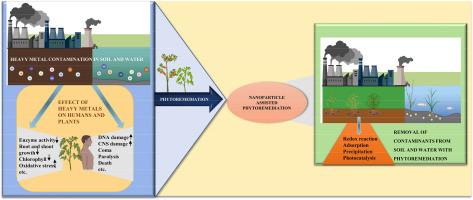Nanoparticle assisted phytoremediation: An eco-friendly approach for removal of heavy metals from the environment
IF 6.3
2区 环境科学与生态学
Q1 ENVIRONMENTAL SCIENCES
引用次数: 0
Abstract
The surge in environmental pollution in recent years driven by numerous pollutants has necessitated the search for efficient removal methods. Phytoremediation is an eco-friendly technique that provides multiple benefits over conventional methods of removing contaminants. Despite the numerous benefits of this technique, it has certain limitations that can be addressed by incorporating nanoparticles to improve its effectiveness. This review paper aims to explore the impact of heavy metal pollution on plants and human health. It highlights the role and mechanism of nanoparticles in enhancing phytoremediation, their application in the detection of heavy metals, and the strategies for the safe disposal of phytoremediation biomass. Biosynthesized nanoparticles are eco-friendly and non-toxic, with applications in biomedical and environmental fields. Nanoparticles can be used in the form of nano biosensors like smartphone-operated wireless sensors made from Cinnamomum camphora, enabling efficient detection of heavy metal ions. According to the studies, nanoparticles remove 80 %–97 % of heavy metals by various methods like reduction, precipitation, adsorption, etc. The phytoremediation biomass disposal can be done by heat treatment, phytomining, and microbial treatment with some modifications to further enhance their results. Phytoremediation is an environmentally friendly technique but requires further research and integration with biomass energy production to overcome scalability challenges and ensure safe biomass disposal.

纳米颗粒辅助植物修复:一种从环境中去除重金属的环保方法
近年来,由于众多污染物导致环境污染激增,因此有必要寻找有效的去除方法。植物修复是一种生态友好的技术,与传统的去除污染物的方法相比,它提供了多种好处。尽管这项技术有很多好处,但它也有一定的局限性,可以通过加入纳米颗粒来提高其有效性。本文旨在探讨重金属污染对植物和人体健康的影响。重点介绍了纳米颗粒在加强植物修复中的作用和机制,在重金属检测中的应用,以及植物修复生物质的安全处理策略。生物合成纳米颗粒具有生态友好、无毒等特点,在生物医学和环境领域具有广泛的应用前景。纳米颗粒可用于纳米生物传感器,如智能手机操作的由樟树制成的无线传感器,可以有效地检测重金属离子。研究表明,纳米颗粒可通过还原、沉淀、吸附等多种方法去除80% ~ 97%的重金属。植物修复生物质处理可以通过热处理、植物矿化和微生物处理等方式进行,并进行一定的修改以进一步提高处理效果。植物修复是一种环境友好型技术,但需要进一步研究并与生物质能源生产相结合,以克服可扩展性挑战并确保生物质的安全处置。
本文章由计算机程序翻译,如有差异,请以英文原文为准。
求助全文
约1分钟内获得全文
求助全文
来源期刊

Journal of Environmental Sciences-china
环境科学-环境科学
CiteScore
13.70
自引率
0.00%
发文量
6354
审稿时长
2.6 months
期刊介绍:
The Journal of Environmental Sciences is an international journal started in 1989. The journal is devoted to publish original, peer-reviewed research papers on main aspects of environmental sciences, such as environmental chemistry, environmental biology, ecology, geosciences and environmental physics. Appropriate subjects include basic and applied research on atmospheric, terrestrial and aquatic environments, pollution control and abatement technology, conservation of natural resources, environmental health and toxicology. Announcements of international environmental science meetings and other recent information are also included.
 求助内容:
求助内容: 应助结果提醒方式:
应助结果提醒方式:


